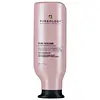What's inside
What's inside
 Key Ingredients
Key Ingredients

No key ingredients
 Benefits
Benefits

No benefits
 Concerns
Concerns

 Ingredients Side-by-side
Ingredients Side-by-side

Water
Skin ConditioningSodium Laureth Sulfate
CleansingCoco-Betaine
CleansingSodium Lauryl Sulfate
CleansingSodium Chloride
MaskingGlycol Distearate
EmollientHexylene Glycol
EmulsifyingParfum
MaskingAminopropyl Triethoxysilane
Acrylates Copolymer
Hydroxypropyl Guar Hydroxypropyltrimonium Chloride
Alcohol Denat.
AntimicrobialPolyquaternium-30
Citric Acid
BufferingBenzyl Alcohol
PerfumingLinalool
PerfumingHexyl Cinnamal
PerfumingMagnesium Nitrate
Alpha-Isomethyl Ionone
PerfumingLimonene
PerfumingMethylchloroisothiazolinone
PreservativeMagnesium Chloride
Methylisothiazolinone
PreservativeSodium Hydroxide
BufferingWater, Sodium Laureth Sulfate, Coco-Betaine, Sodium Lauryl Sulfate, Sodium Chloride, Glycol Distearate, Hexylene Glycol, Parfum, Aminopropyl Triethoxysilane, Acrylates Copolymer, Hydroxypropyl Guar Hydroxypropyltrimonium Chloride, Alcohol Denat., Polyquaternium-30, Citric Acid, Benzyl Alcohol, Linalool, Hexyl Cinnamal, Magnesium Nitrate, Alpha-Isomethyl Ionone, Limonene, Methylchloroisothiazolinone, Magnesium Chloride, Methylisothiazolinone, Sodium Hydroxide
Water
Skin ConditioningCetearyl Alcohol
EmollientBehentrimonium Chloride
PreservativeCetyl Esters
EmollientIsopropyl Myristate
EmollientIsopropyl Alcohol
SolventPhenoxyethanol
PreservativeParfum
MaskingPolyquaternium-37
Propylene Glycol Dicaprylate/Dicaprate
EmollientTocopherol
AntioxidantGlycerin
HumectantButylene Glycol
HumectantPPG-1 Trideceth-6
Skin ConditioningChlorhexidine Dihydrochloride
AntimicrobialHydroxypropyltrimonium Hydrolyzed Wheat Protein
Skin ConditioningHelianthus Annuus Seed Extract
Skin ConditioningWheat Amino Acids
Skin ConditioningHydrolyzed Vegetable Protein Pg-Propyl Silanetriol
Skin ConditioningSodium Chloride
MaskingSorbitan Oleate
EmulsifyingBenzophenone-4
UV AbsorberCitric Acid
BufferingLimonene
PerfumingEucalyptus Globulus Leaf Extract
PerfumingAscorbic Acid
AntioxidantPotassium Sorbate
PreservativeDisodium EDTA
Water, Cetearyl Alcohol, Behentrimonium Chloride, Cetyl Esters, Isopropyl Myristate, Isopropyl Alcohol, Phenoxyethanol, Parfum, Polyquaternium-37, Propylene Glycol Dicaprylate/Dicaprate, Tocopherol, Glycerin, Butylene Glycol, PPG-1 Trideceth-6, Chlorhexidine Dihydrochloride, Hydroxypropyltrimonium Hydrolyzed Wheat Protein, Helianthus Annuus Seed Extract, Wheat Amino Acids, Hydrolyzed Vegetable Protein Pg-Propyl Silanetriol, Sodium Chloride, Sorbitan Oleate, Benzophenone-4, Citric Acid, Limonene, Eucalyptus Globulus Leaf Extract, Ascorbic Acid, Potassium Sorbate, Disodium EDTA
 Reviews
Reviews

Ingredients Explained
These ingredients are found in both products.
Ingredients higher up in an ingredient list are typically present in a larger amount.
Citric Acid is an alpha hydroxy acid (AHA) naturally found in citrus fruits like oranges, lemons, and limes.
Like other AHAs, citric acid can exfoliate skin by breaking down the bonds that hold dead skin cells together. This helps reveal smoother and brighter skin underneath.
However, this exfoliating effect only happens at high concentrations (20%) which can be hard to find in cosmetic products.
Due to this, citric acid is usually included in small amounts as a pH adjuster. This helps keep products slightly more acidic and compatible with skin's natural pH.
In skincare formulas, citric acid can:
While it can provide some skin benefits, research shows lactic acid and glycolic acid are generally more effective and less irritating exfoliants.
Most citric acid used in skincare today is made by fermenting sugars (usually from molasses). This synthetic version is identical to the natural citrus form but easier to stabilize and use in formulations.
Read more about some other popular AHA's here:
Learn more about Citric AcidLimonene is a fragrance that adds scent and taste to a formulation.
It's found in the peel oil of citrus fruits and other plants such as lavender and eucalyptus. The scent of limonene is generally described as "sweet citrus".
Limonene acts as an antioxidant, meaning it helps neutralize free radicals.
When exposed to air, oxidized limonene may sensitize the skin. Because of this, limonene is often avoided by people with sensitive skin.
The term 'fragrance' is not regulated in many countries. In many cases, it is up to the brand to define this term. For instance, many brands choose to label themselves as "fragrance-free" because they are not using synthetic fragrances. However, their products may still contain ingredients such as essential oils that are considered a fragrance.
Learn more about LimoneneParfum is a catch-all term for an ingredient or more that is used to give a scent to products.
Also called "fragrance", this ingredient can be a blend of hundreds of chemicals or plant oils. This means every product with "fragrance" or "parfum" in the ingredients list is a different mixture.
For instance, Habanolide is a proprietary trade name for a specific aroma chemical. When used as a fragrance ingredient in cosmetics, most aroma chemicals fall under the broad labeling category of “FRAGRANCE” or “PARFUM” according to EU and US regulations.
The term 'parfum' or 'fragrance' is not regulated in many countries. In many cases, it is up to the brand to define this term.
For instance, many brands choose to label themselves as "fragrance-free" because they are not using synthetic fragrances. However, their products may still contain ingredients such as essential oils that are considered a fragrance by INCI standards.
One example is Calendula flower extract. Calendula is an essential oil that still imparts a scent or 'fragrance'.
Depending on the blend, the ingredients in the mixture can cause allergies and sensitivities on the skin. Some ingredients that are known EU allergens include linalool and citronellol.
Parfum can also be used to mask or cover an unpleasant scent.
The bottom line is: not all fragrances/parfum/ingredients are created equally. If you are worried about fragrances, we recommend taking a closer look at an ingredient. And of course, we always recommend speaking with a professional.
Learn more about ParfumChances are, you eat sodium chloride every day. Sodium Chloride is also known as table salt.
This ingredient has many purposes in skincare: thickener, emulsifier, and exfoliator.
You'll most likely find this ingredient in cleansers where it is used to create a gel-like texture. As an emulsifier, it also prevents ingredients from separating.
There is much debate on whether this ingredient is comedogenic. The short answer - comedogenic ratings don't tell the whole story. Learn more about comegodenic ratings here.
The concensus about this ingredient causing acne seems to be divided. Research is needed to understand if this ingredient does cause acne.
Scrubs may use salt as the primary exfoliating ingredient.
Learn more about Sodium ChlorideWater. It's the most common cosmetic ingredient of all. You'll usually see it at the top of ingredient lists, meaning that it makes up the largest part of the product.
So why is it so popular? Water most often acts as a solvent - this means that it helps dissolve other ingredients into the formulation.
You'll also recognize water as that liquid we all need to stay alive. If you see this, drink a glass of water. Stay hydrated!
Learn more about Water